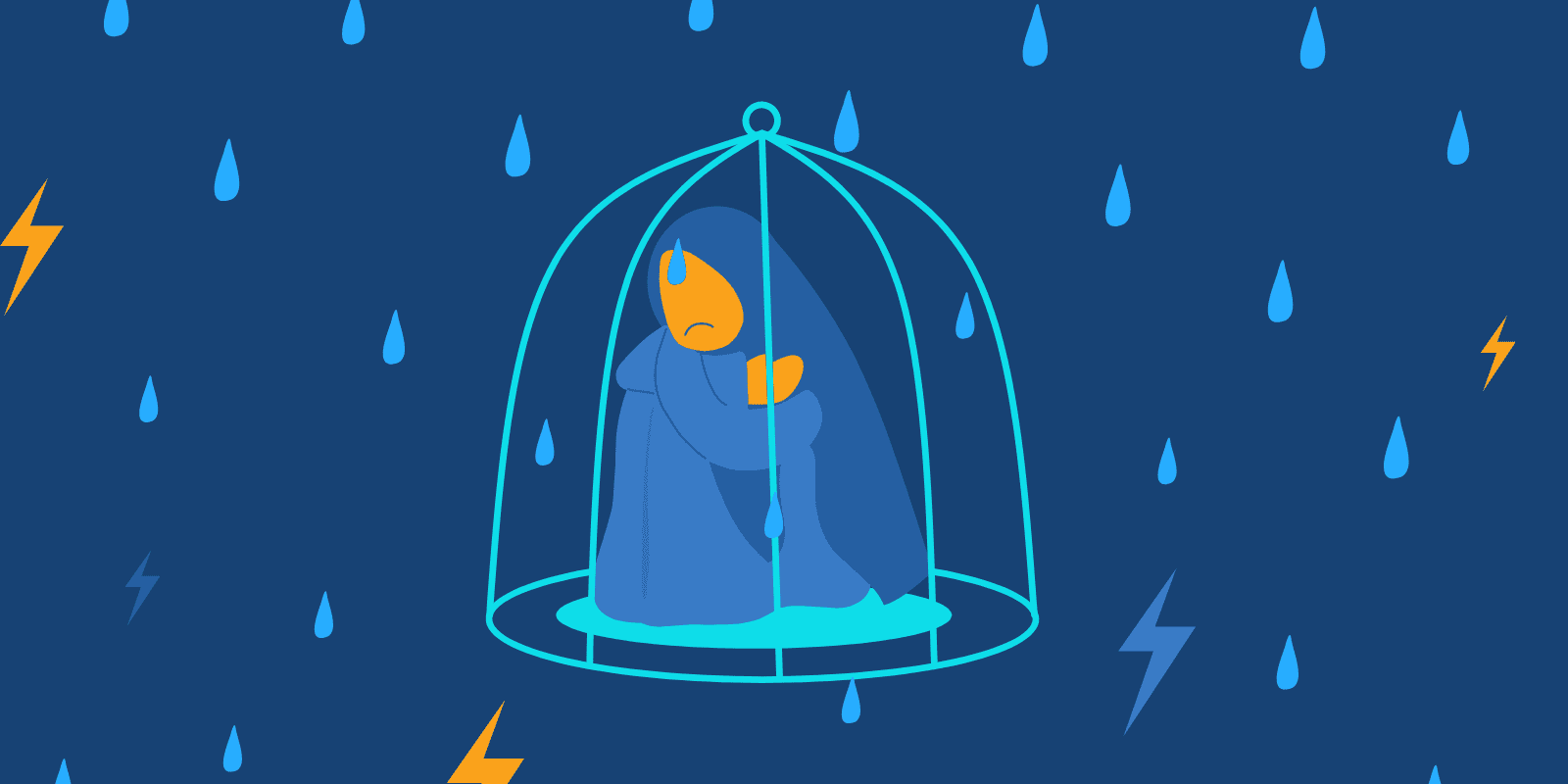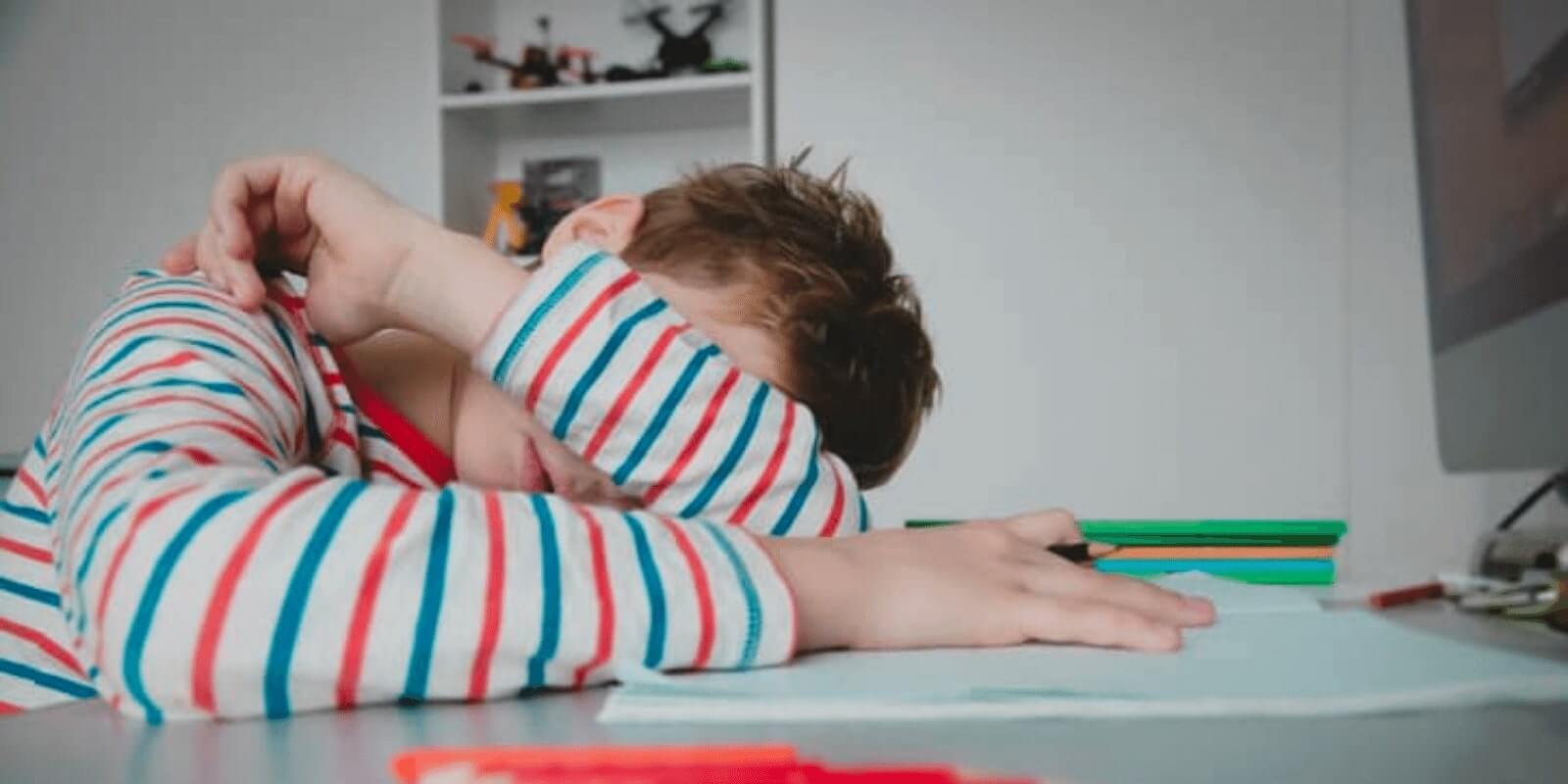What Is Avoidance Behavior?
Avoidance behavior is when your teen keeps away from social situations that cause distressing thoughts and feelings.
Your child might throw tantrums, fake being sick, or fail on purpose to get out of activities due to fear of being in front of others. Teens who avoid social situations will have a hard time developing confidence and self-esteem.
Avoidance behaviors include extreme ways to get out of specific activities that cause uncomfortable thoughts and feelings. These can be extracurricular activities, spending time with family members, going back to school, dates, or other social situations.
Your child isn’t avoiding the situation as much as they are avoiding their thoughts and feelings. Avoidance is a maladaptive way of coping with anxiety during social situations and making decisions.
These behaviors are a way to get out of doing things that your teen might fear will lead to being judged, criticized, rejected, or in the spotlight.

While your child might prefer not being in crowds or in the spotlight, avoidance behaviors are different. These behaviors cause stress, which creates a cycle with more avoidance. Young people might miss out on their teenage years when avoiding their fears.
With avoidance behaviors, your teen will take extreme measures to get out of things that they actually want to do.
Sometimes, your teen might avoid situations that make them feel overwhelmed, bored, uncomfortable, or overstimulated.
Your child might also use avoidance to get out of nonpreferred activities. Teens can learn to communicate why they want to avoid specific things to empower them to speak up for themselves.
For example, some kids might be more introverted than others. Your child might prefer quiet time alone or have only a few close friendships. They might not like large social gatherings or noisy environments.
Everyone has different preferences, and you can’t expect your child to love everything. Sometimes, your child is avoiding something just because they find the activity boring or overwhelming.
But, when kids use avoidance and miss out on life or feel shame and guilt afterward, avoidance can be considered a maladaptive coping skill.

What Is An Example Of Avoidance?
An example of avoidance is failing an audition on purpose to avoid being in the spotlight.
If a young person struggles with anxiety or feeling uncomfortable in front of others, they might sabotage themselves. For example, if your child plays trumpet in the high school band, they might play poorly in front of others to avoid being in the spotlight.
When a child under-performs in a sport or extracurricular activity in public, this might be an example of avoidance behavior. Knowing that they are purposefully sabotaging themselves can lead to guilt, shame, or low self-esteem.
To help kids with avoidance, you need to help them with the underlying issues. Your child might have mental health issues that make them feel like they don’t deserve success or fear being judged, even when they excel at activities.
Substance abuse can also be an example of avoidance.
Teens might turn to alcohol or substance use to avoid dealing with discomfort. When teens have social anxiety, they might use substances to self-medicate. Young people might consider substances and alcohol use to be a “social lubricant.”
Teens who struggle with low self-esteem might also turn to alcohol and substance use when they have weak boundaries with others. They might not have the confidence to escape peer pressure when introduced to substances.
Knowing what to do to help your child involves understanding what avoidance might be a symptom of. Once you know the root of the problem, you can help guide your teen’s behavior toward developing strengths and gaining confidence.
What Is Avoidance A Symptom Of?
Avoidance can be a symptom of many issues, such as:
- Social Anxiety Disorder
- Low Self-Esteem
- Post-Traumatic Stress Disorder (PTSD)
- Generalized Anxiety Disorder (GAD)
- Obsessive-Compulsive Disorder (OCD)
- Avoidant Personality Disorder (AVPD)
- Depression
- Attention-Deficit/Hyperactivity Disorder (ADHD)
- Fear of failure or fear of success
Fear of failure and fear of success are closely linked. Sometimes, a child might fear success due to the pressure that comes along with it. If they excel at something, they might then worry about failing down the road.

Depending upon what situations your child avoids can provide clues to uncovering the underlying self-esteem and mental health issues causing avoidance.
To help kids through avoidance, you should consider the following:
- What is your child avoiding? Going to school? Family outings? Specific places, etc.?
- Does your child avoid specific people or behave differently around specific people?
- Does your child appear happy and confident at home yet are shy and quiet at school?
Understanding the specifics of a teen’s behavior gives parents clues to help kids overcome avoidance.
For example, if your child has tantrums about getting back to school after a break, they might have ADHD. ADHD might lead to low performance in class, failing grades, and low self-esteem. Your child could benefit from psychiatry and learning support to help them.
What Are Avoidance Techniques?
Avoidance techniques can vary and are attempts to avoid specific situations or decisions.
Some kids might display subtle avoidance techniques, which are difficult to notice. However, some kids can use intense avoidance techniques.
Some common avoidance techniques include:
- Faking physical health problems, like stomach aches or being sick that appear suddenly and consistently around specific events
- Oversleeping or always claiming to be too tired to get out of certain activities
- Alcohol and substance abuse to self-medicate and get through uncomfortable situations or numb distressing thoughts and feelings
- Procrastinating or wanting everything to be perfect or “just right” before engaging in the event triggering avoidance
- Rumination or obsessive thinking through an issue or conflict instead of facing the problem
- Self-defeating behaviors that underscore a teen’s abilities
- Distraction in the form of excessive time on phones, social media, video games, and other activities
- Tantrums or meltdowns to avoid distressing emotions or activities

Using distractions might work in the short term to manage discomfort or even be healthy. For example, a child might play a video game on their phones to avoid feeling bored waiting at a doctor’s office.
However, when distractions and other avoidance behaviors become the preferred way to deal with any discomfort or to get out of doing meaningful activities, kids might have adopted these behaviors as unhealthy coping strategies.
Parents and caregivers can help kids get comfortable with discomfort to teach them that uncomfortable feelings are not the end of the world.
Is Avoidance A Form Of Anxiety?
Avoidance is not a form of anxiety, but avoidance might be a sign of an anxiety disorder.
Anxiety disorders can lead to changing your behavior to minimize your anxiety. Avoidance becomes a coping strategy that might work in some cases, and then your child uses avoidance as one of their only coping strategies.
When a child with an anxiety disorder uses avoidance exclusively, they never learn how to manage their disorder in a healthy way. When kids don’t learn healthy coping strategies to manage anxiety, their anxiety can worsen over time.
Anxiety might be rooted in specific phobias or fears, which require exposure to overcome.
Most anxiety disorders are rooted in fear. Obsessive-compulsive disorder is the fear of losing control. Social anxiety disorder is the fear of being judged in social situations. The fear of dying might be a form of anxiety known as panic disorder.
Where avoidance might work to escape these uncomfortable feelings, avoidance diminishes a young person’s quality of life. When teens do not overcome their anxiety, they begin to generalize avoidance as a strategy.

As teenagers become young adults, new situations arise that bring about new fears and uncertainties. If young adults only rely on avoidance to cope, they might isolate themselves or never realize their full potential.
Avoidance behaviors can also escalate in severity and create a cycle of shame, as young people might blame themselves for not being happy or fulfilled.
To overcome anxiety, your child needs to expose themselves to the source of their anxiety. Therapies like cognitive behavioral therapy (CBT) help teach young people to confront anxiety and irrational fears.
What Causes Avoidance Behavior?
Avoidance behavior is caused by feelings of discomfort associated with specific situations.
Avoidance is a maladaptive way of coping with uncomfortable thoughts and feelings caused by either internal or external events. Internal events are thoughts or beliefs. External events are social situations associated with feelings of anxiety or fear.
For a young person with OCD, they are avoiding the internal events of intrusive thoughts by engaging in ritualistic obsessions. These obsessive behaviors include excessive cleaning, attention to order, and completing a task a certain number of times to feel “just right.”
Young people with social anxiety might avoid socializing to avoid the uncomfortable feelings of being in front of others. The social event is the external stimuli that trigger feelings of inadequacy or being judged by others.
It’s important to remember that the uncomfortable feelings cause the avoidance and not the events themselves.

Even when the trigger of avoidance is internal, like intrusive thoughts, these thoughts do not directly cause avoidance behaviors. Instead, the feelings become associated with the internal or external event.
Your child is not avoiding the event but avoiding the feelings triggered.
Young people can develop healthy coping skills to manage these uncomfortable feelings. While avoidance might have worked to stop the discomfort, your child will continue to miss out on living their lives if they use avoidance to deal with feelings of discomfort.
What Is Avoidant Personality Disorder?
Avoidant personality disorder is a mental health disorder that might develop after using avoidant behaviors for years.
Kids and teenagers are unlikely to be diagnosed with avoidant personality disorder. However, avoidance behaviors learned during teen years can lead to developing this disorder as a young adult.
Young adults with avoidant personality disorder might avoid any situation that can lead to failure or embarrassment. They might struggle with any form of criticism and have a difficult time forming intimate relationships.
Avoidant personality disorder can be treated with long-term psychotherapy to teach the person healthy coping skills to deal with vulnerability and failure and build self-confidence.
What Is Cognitive Avoidance?
Cognitive avoidance is when you try to stop yourself from specific thoughts and feelings.
You might use other unproductive thinking to distance yourself from feelings and other challenging thoughts. You might excessively worry about every potential negative outcome to put off making a decision.
Cognitive avoidance can be excessive worrying, mental compulsions, or rumination that gets in the way of problem-solving and decision-making.
For young people, you might see them delay their decisions to move on to college or get a job after high school. They might come up with a list of every possible negative outcome for why they cannot move out of their home towns or take a particular job opportunity.
While thinking critically about the pros and cons is crucial to decision-making, when young people only consider the negatives, they might be using cognitive avoidance to deal with challenging emotions.
For example, after high school, young people deal with a lot of stressful realities. Friends might be moving away, they need to make decisions about going to school or working, or they might have their first experience with independence from their parents.

While thinking through future actions and wanting to steer clear of adverse outcomes might appear rational, when used excessively, young people might be delaying decisions. You can help them by getting to the root cause of their feelings.
Are they afraid to move on? Will they miss their friends? Do they feel ready to make important life decisions? By understanding the specifics, parents can help kids move past what is really bothering them.
Cognitive avoidance is also common among those with obsessive-compulsive disorder (OCD).
OCD is an anxiety disorder where you experience intrusive and unwanted thoughts. With OCD, you attempt to control these thoughts with ritualistic behaviors, which can include cognitive avoidance.
With OCD, a young person might be preoccupied with an intrusive and distressing thought that they want to control. In the short term, cognitive avoidance might work to distract them from obsessive thoughts.
However, young people with OCD can learn to accept their intrusive thoughts as just thoughts, which are not harmful. They might internalize these unwanted thoughts and attempt to use excessive worries to “rid” themselves of these thoughts.
Any of these cognitive avoidance strategies become maladaptive for OCD and long-term decision-making because they lead to greater stress and anxiety.
What Is Intimacy Avoidance?
Intimacy avoidance occurs when you fear getting close to others, like friends, family, or romantic partners.
Intimacy is often associated with sexual activity. However, intimacy means being close to someone emotionally. Often, romantic partners have intimate relationships that include sexual activity. But sexual activity doesn’t always mean a relationship is intimate.
Intimacy is the closeness within relationships and requires sharing emotional connections.

Young people might struggle to build long-term friendships or meaningful relationships if they fear intimate conversations. They might have friendships with little emotional depth because they fear being judged for their vulnerable emotions.
Kids might build unhealthy friendships around alcohol or drug use, as these peers might use substances to numb themselves while getting close to one another. These friendships can be unhealthy or enable substance abuse as a way of opening up emotionally.
Intimacy avoidance might also be rooted in fear of conflicts with others.
Every friendship or relationship will have some form of conflict. Sometimes, conflict leads to a greater understanding of one another. Other times, conflict can lead to breakups, rough patches, or disruptive changes in relationships.
Learning to manage conflicts with others and knowing when a conflict is too large to continue the relationship can help young people maintain healthy relationships and boundaries throughout their lives.
Group therapy can help kids learn to open up in front of others, teaching them not to fear being judged for their emotions.
When kids avoid intimacy, they really fear rejection, judgment, a lack of acceptance for who they are, and being perceived as weak or overly emotional. They might be stoic and hold everything in. They might develop a lot of superficial friendships.
Group therapy can also be a place to act out specific social situations and practice dealing with conflict.
To develop healthy relationships as young adults, young people will need to get comfortable with the discomfort of being vulnerable. With practice in a therapeutic environment, they can learn that opening up to others is nothing to fear.
How Can We Break The Cycle Of Avoidance For My Child?

For parents asking how to break the cycle of avoidance, there are solutions for you to try with your child:
- Empowering kids with more choices
- We can involve our kids in more decision-making when possible.
- Sometimes, we narrow choices to limited options for things like extracurricular activities and household chores.
- For example, if your child struggles with self-confidence and self-sabotages often, maybe they need a new activity with lower demands to build up self-confidence first.
- Psychotherapy in either groups or individual treatment
- Cognitive-behavioral therapy is proven to help kids deal with distressing thoughts, difficult emotions, and self-defeating thoughts.
- Group therapy can teach kids to feel comfortable in front of others in a safe environment.
- Psychiatry can help with underlying mental health problems
- If your child has ADHD, they might avoid schoolwork because they struggle to get things done.
- Medications can help to treat ADHD, along with anxiety, depression, and other issues.
- Always look at medication after trying other options first.
Teen avoidance behavior can be challenging for kids to overcome. You might see extreme or subtle signs of avoidance that might be a sign of an underlying mental health issue. Sandstone Care is here for teens and young adults. Call us today at (888) 850-1890.







